- Georgia blue wave speculation drives Treasuries, dollar lower
- NASDAQ futures bleed while small cap futures rocket
- US-China relations flare after apps ban
Key Events
The prospect of a blue wave in the aftermath of the two Senate runoffs in Georgia is driving NASDAQ futures significantly lower in trading on Wednesday. Traders are concerned that Democratic lawmakers in full control of Congress will wage an antitrust campaign against big tech. Futures on the Dow and S&P were mixed.
At the same time, contracts on the Russell 2000 have jumped as the cyclical rotation gathers pace.
Yields on the 10-Year Treasury note topped 1% for the first time since March and the dollar extended its sellfoff as markets priced in uncontested Democratic legislative rule. Bitcoin surpassed $35,000 for the first time.
Global Financial Affairs
Democrats have already unseated}} Republican Senator Kelly Loeffler in one of the Georgia races, with Democrat Raphael Warnock becoming the deep South state's first Black senator. The second race, between Democrat Jon Ossoff and Republican David Perdue, remains too close to call at time of writing, although momentum is pointing to another Democratic win.
If the Democrats control both chambers of Congress, in addition to the White House, it would allow them to deliver a bigger economic aid package, which would help the economic recovery. However, President-elect Joseph Biden's plan to hike taxes and undo President Donald Trump’s rollback of regulations could offset the Democratic policies considered positive for economic growth.
The cyclical rotation in stocks increased in pre-US market trading on Wednesday. The European energy sector also posted strong gains.
Asian shares were mixed, with US-China relations were on the rocks again as President Donald Trump signed an executive order banning business with eight Chinese apps, citing national security. This move counterbalances investors’ relief yesterday when the New York Stock Exchange backtracked on delisting China’s three biggest state-owned telecom companies. Traders may wonder whether this daily Sino seesaw indicates a lack of policy integrity or if there is something deeper unfolding.
Nevertheless, Chinese shares in Asia were the only ones in the green, both on the mainland and in Hong Kong’s financial hub. The Shanghai Composite increased 0.6%, as the services sector extended growth in December, even if at a slower rate.
Equities rose on Wall Street during Tuesday’s session, while Treasuries declined. The S&P 500 Index rebounded from its worst start of the year since 2016, led by energy stocks, with oil nearing $50. The Russell 2000 surged 2%, leaving the other benchmarks far behind.
Yields on the 10-year Treasury note jumped above the psychological level of 1.00% for the first time since March. A Democrat-dominant Congress may boost inflation, and with it, interest rates, as well as taxes to pay for additional fiscal support.
Traders foresee a minimum of 2% inflation a year over the next decade, based on the 10-year breakeven rate, a measure that draws on pricing for inflation-linked Treasuries. Bond traders were pricing in a blue sweep in the Senate runoff, spurring the yield curve to steepen to multi-year highs as the fiscal conditions would be unsustainable.
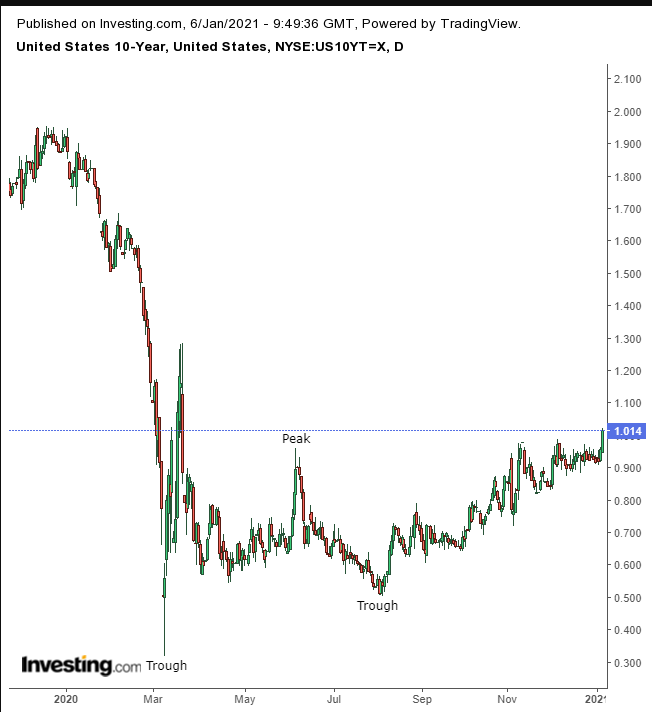
Rates posted the second high required to establish an uptrend.
Concerns that additional stimulus would further dilute the value of the dollar pushed the greenback down for the third straight day.
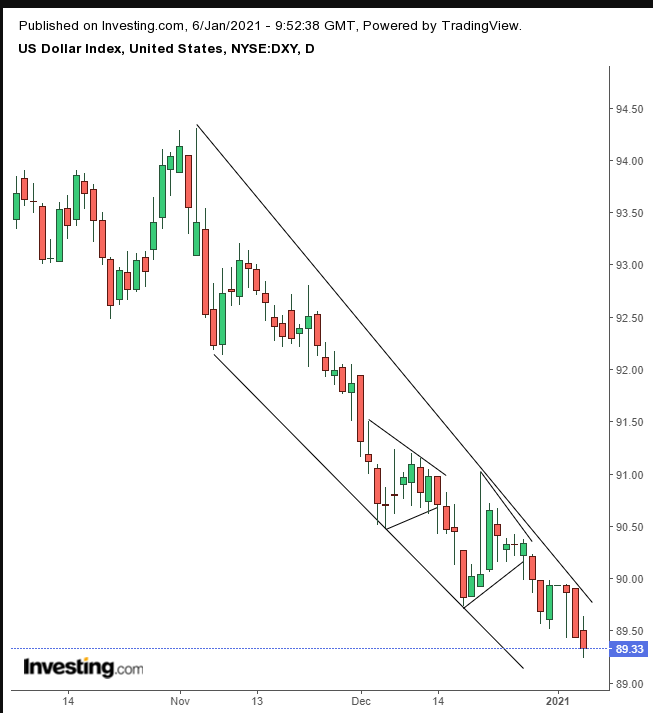
The greenback is breaking the support of Monday’s long-legged hammer. If the 89.50 level doesn't hold, the USD is expected to extend its decline within its falling channel, after completing back-to-back continuation patterns.
Dollar and equity weakness propelled gold higher to a third consecutive daily rise.
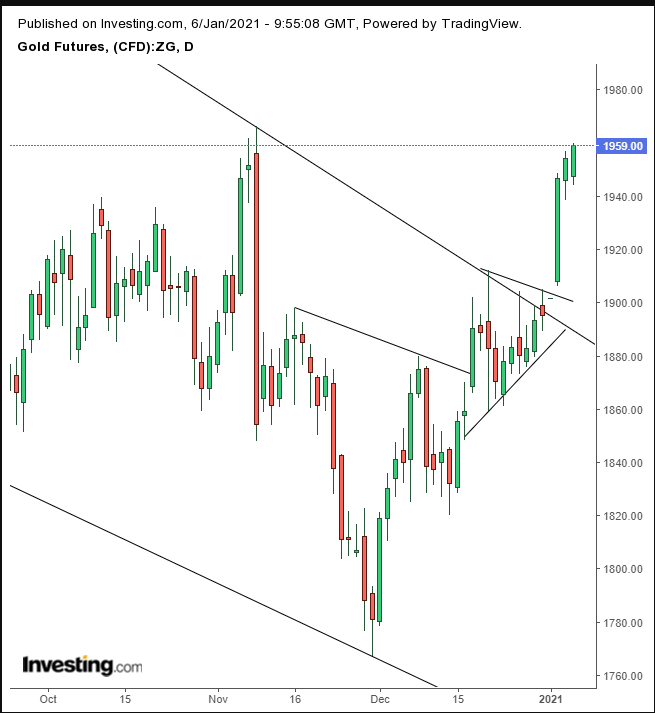
The yellow metal extended the upside breakout of a falling channel since its first record in August 2011, after completing a H&S bottom followed by an immediate bullish pennant.
Bitcoin scored a new all-time high of $35,157.
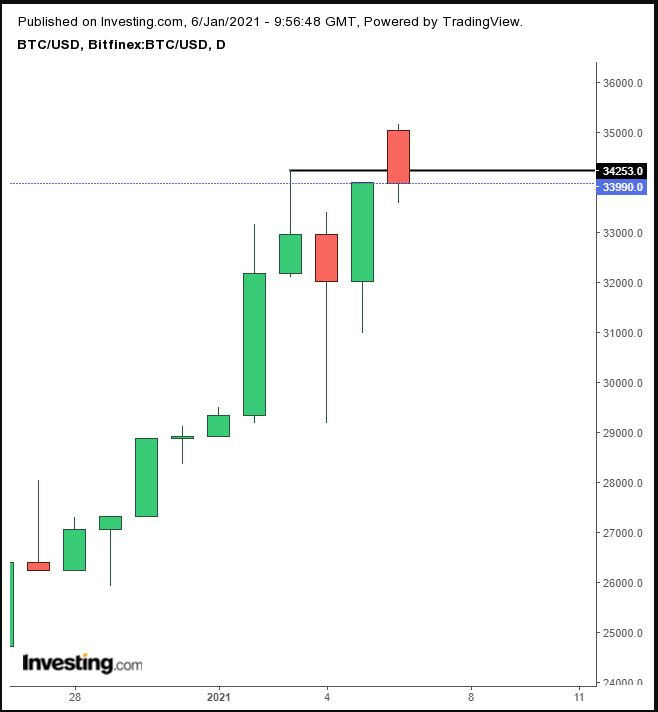
However, the cryptocurrency gave it all back and edged lower from Tuesday’s close, keeping to the resistance fo Sunday’s shooting star.
Oil crossed the $50 milepost after Saudi Arabia {{news-2380569||surprised with a large reduction in the output for February and March, carrying a greater burden of OPEC+ cuts while other producers continue mostly as usual.
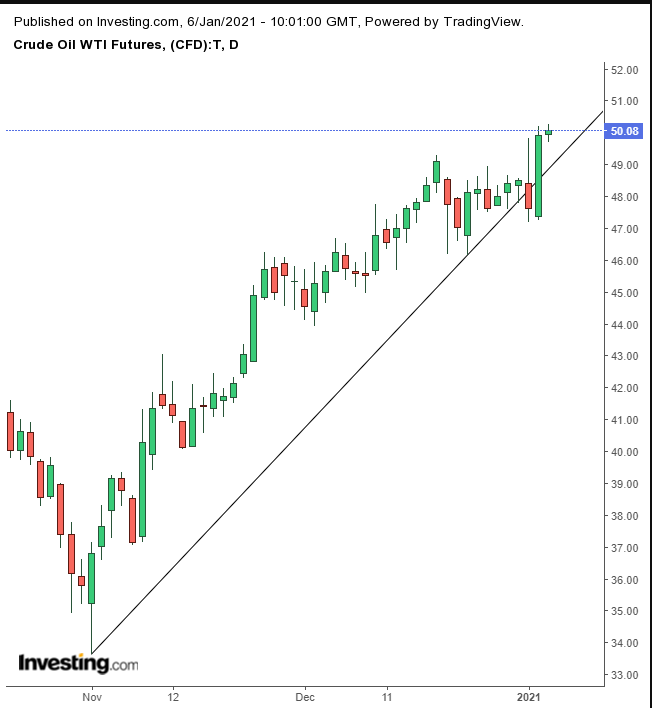
Crossing the $50 level for WTI has a psychological impact that could lead to further demand. The price posted a new high above the Dec. 18 high, with which it has struggled since, as attested by Monday’s shooting star.
Up Ahead
- US Congress meets to count electoral votes and officially declare the winner of the 2020 Presidential election Wednesday.
- On Wednesday, the FOMC minutes are published.
- On Friday the monthly US unemployment rate and nonfarm payrolls report will be released.
Market Moves
Stocks
- Futures on the S&P 500 Index decreased 0.7%.
- The STOXX 600 Index gained 0.1%.
- The MSCI Asia Pacific Index was little changed.
- The MSCI Emerging Markets Index rose 0.2%.
Currencies
- The Dollar Index decreased 0.2% to 89.32.
- The euro climbed 0.2% to $1.2324.
- The British pound increased 0.1% to $1.3635.
- The Japanese yen weakened 0.1% to 102.80 per dollar.
Bonds
- The yield on 10-year Treasuries gained five basis points to 1%.
- The yield on two-year Treasuries gained one basis point to 0.13%.
- Germany’s 10-Year yield increased six basis points to -0.51%.
- Britain’s 10-year yield gained four basis points to 0.247%.
Commodities
- West Texas Intermediate crude was little changed at $49.83 a barrel.
- Gold was little changed at $1,949.26 an ounce.
